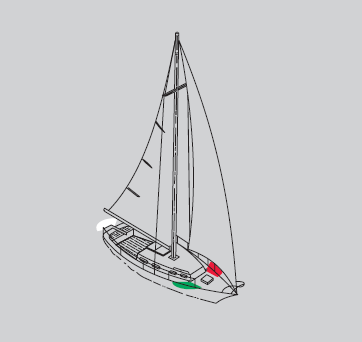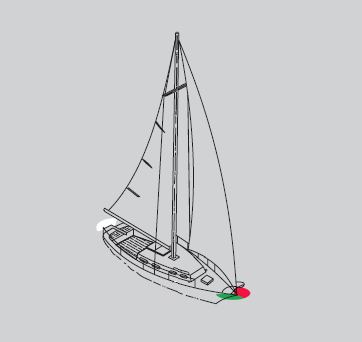Difference between revisions of "Sidelights"
m (clarifying grammar) |
|||
| (2 intermediate revisions by one user not shown) | |||
| Line 3: | Line 3: | ||
The red sidelight is on the port side and the green sidelight is on the starboard side. One way to remember this is to consider that ''port wine'' is red, and thus the port sidelight is also red. | The red sidelight is on the port side and the green sidelight is on the starboard side. One way to remember this is to consider that ''port wine'' is red, and thus the port sidelight is also red. | ||
| − | + | Each sidelight is required to shine over an angle of 112.5 degrees, from directly forward, to each respective side of the boat. | |
[[Image:Navlights1.png]] [[Image:Navlights2.png]] | [[Image:Navlights1.png]] [[Image:Navlights2.png]] | ||
| Line 15: | Line 15: | ||
The phrase "red, right, returning" can be applied when viewing other boats. If you see a red and a green light on a boat at night and the ''red'' light is to the ''right'' of the green light, then you know the boat is pointed at you ("''returning''" to you). This is also true with airplanes. | The phrase "red, right, returning" can be applied when viewing other boats. If you see a red and a green light on a boat at night and the ''red'' light is to the ''right'' of the green light, then you know the boat is pointed at you ("''returning''" to you). This is also true with airplanes. | ||
| − | The sidelights are also helpful when remembering who has the right of way at night. If you are in a motor-powered boat and approaching another motor-powered boat at an angle (not head-on), and you can see their green sidelight, then you have the right of way. If you can see their red port | + | The sidelights are also helpful when remembering who has the right of way at night. If you are in a motor-powered boat and approaching another motor-powered boat at an angle (not head-on or from astern), and you can see their green sidelight, then you have the right of way. If you can see their red port sidelight, then the other boat has the right of way and you must maneuver to avoid them. This is easy to remember because green means go (stay on course), and red means stop (give way). |
| + | |||
| + | == See Also == | ||
| + | |||
| + | |||
| + | * [[Safety Requirements#Navigation Lights|Navigation Lights Safety Requirements]] | ||
== External Links == | == External Links == | ||
| − | [http://www.navcen.uscg.gov/mwv/navrules/navrules.htm USCG Navigation Rules] | + | * [http://www.navcen.uscg.gov/mwv/navrules/navrules.htm USCG Navigation Rules] |
| + | |||
| + | [[Category:Sailing Terms]] | ||
Latest revision as of 21:58, 3 May 2008
The term "sidelights" refers to the red and green navigation lights that are required on most boats between sunset and sunrise.
The red sidelight is on the port side and the green sidelight is on the starboard side. One way to remember this is to consider that port wine is red, and thus the port sidelight is also red.
Each sidelight is required to shine over an angle of 112.5 degrees, from directly forward, to each respective side of the boat.
On large boats, each sidelight must be a single light on either side of the vessel. On boats less than 20m (39.4 ft.), the red and green lights can be combined in a single fixture at the front of the boat.
On boats greater than 50m (164 ft.) in length, the sidelights must be visible for a distance of three miles. On boats greater than 12m (39.4 ft.), the sidelights must be visible for two miles. On boats less than 12m, the sidelights must be visible for at least one mile.
On sailboats, it is permitted to use a "tricolor light" at the top of the mast to replace the sidelights and sternlight. Use of a tricolor light is only permitted when the boat is sailing and not under motor power.
The phrase "red, right, returning" can be applied when viewing other boats. If you see a red and a green light on a boat at night and the red light is to the right of the green light, then you know the boat is pointed at you ("returning" to you). This is also true with airplanes.
The sidelights are also helpful when remembering who has the right of way at night. If you are in a motor-powered boat and approaching another motor-powered boat at an angle (not head-on or from astern), and you can see their green sidelight, then you have the right of way. If you can see their red port sidelight, then the other boat has the right of way and you must maneuver to avoid them. This is easy to remember because green means go (stay on course), and red means stop (give way).

